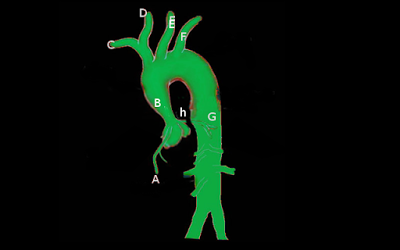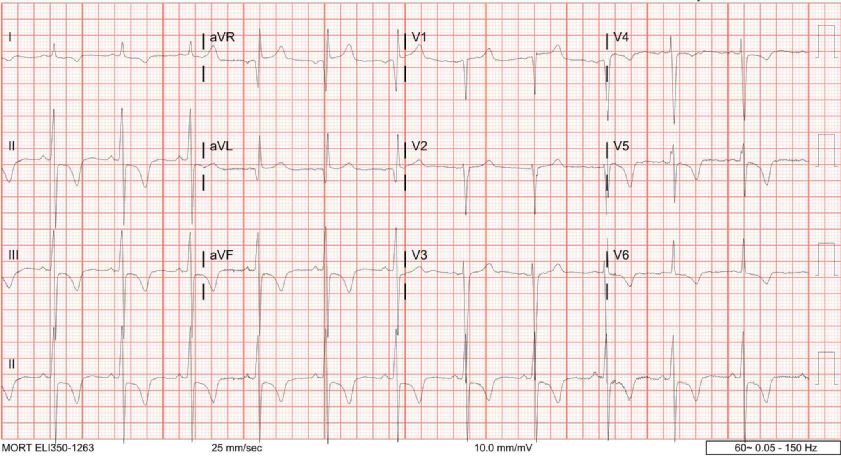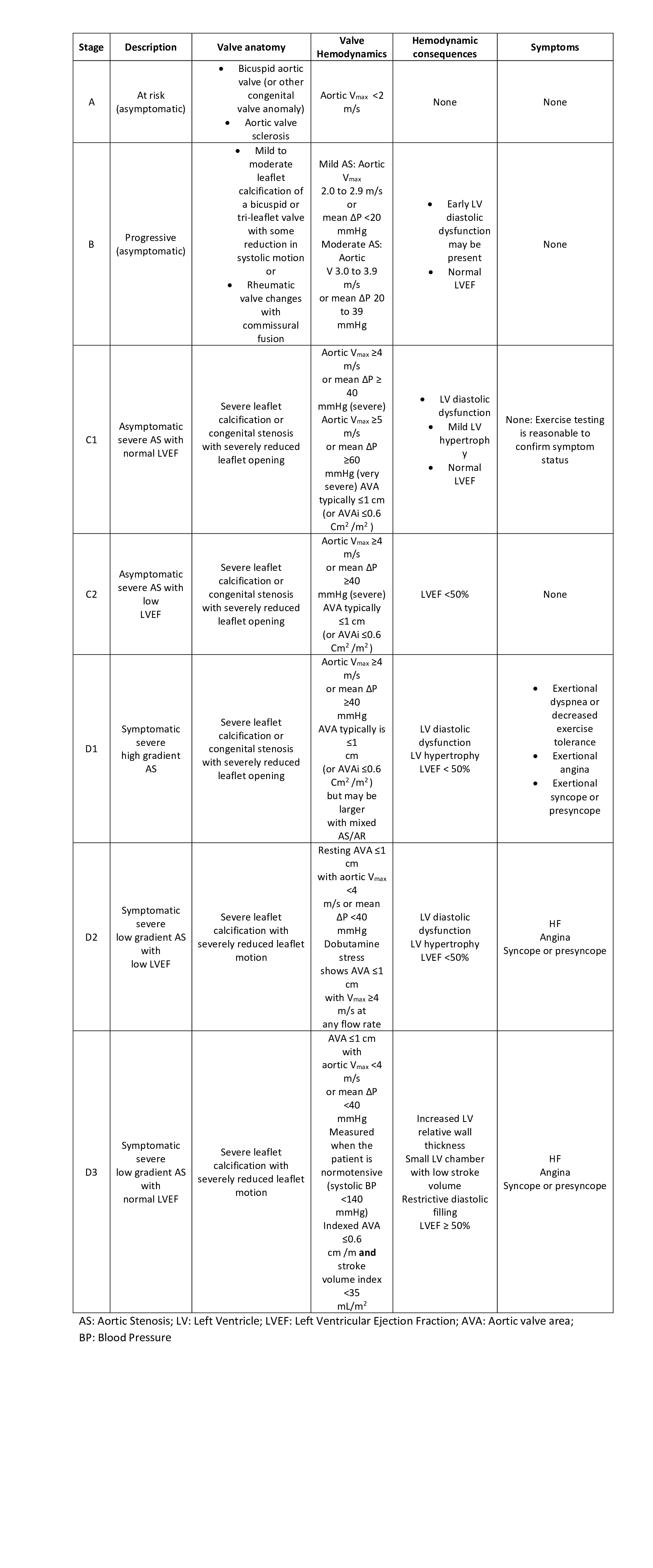[1]
Nkomo VT,Gardin JM,Skelton TN,Gottdiener JS,Scott CG,Enriquez-Sarano M, Burden of valvular heart diseases: a population-based study. Lancet (London, England). 2006 Sep 16
[PubMed PMID: 16980116]
[2]
Généreux P,Stone GW,O'Gara PT,Marquis-Gravel G,Redfors B,Giustino G,Pibarot P,Bax JJ,Bonow RO,Leon MB, Natural History, Diagnostic Approaches, and Therapeutic Strategies for Patients With Asymptomatic Severe Aortic Stenosis. Journal of the American College of Cardiology. 2016 May 17
[PubMed PMID: 27049682]
[3]
Turina J,Hess O,Sepulcri F,Krayenbuehl HP, Spontaneous course of aortic valve disease. European heart journal. 1987 May
[PubMed PMID: 3609042]
[4]
Pellikka PA,Nishimura RA,Bailey KR,Tajik AJ, The natural history of adults with asymptomatic, hemodynamically significant aortic stenosis. Journal of the American College of Cardiology. 1990 Apr
[PubMed PMID: 2312954]
[5]
Pai RG,Kapoor N,Bansal RC,Varadarajan P, Malignant natural history of asymptomatic severe aortic stenosis: benefit of aortic valve replacement. The Annals of thoracic surgery. 2006 Dec
[PubMed PMID: 17126122]
[6]
Varadarajan P,Kapoor N,Bansal RC,Pai RG, Clinical profile and natural history of 453 nonsurgically managed patients with severe aortic stenosis. The Annals of thoracic surgery. 2006 Dec
[PubMed PMID: 17126120]
[7]
Nishimura RA,Otto CM,Bonow RO,Carabello BA,Erwin JP 3rd,Fleisher LA,Jneid H,Mack MJ,McLeod CJ,O'Gara PT,Rigolin VH,Sundt TM 3rd,Thompson A, 2017 AHA/ACC Focused Update of the 2014 AHA/ACC Guideline for the Management of Patients With Valvular Heart Disease: A Report of the American College of Cardiology/American Heart Association Task Force on Clinical Practice Guidelines. Journal of the American College of Cardiology. 2017 Jul 11
[PubMed PMID: 28315732]
Level 1 (high-level) evidence
[10]
Senechal M,Germain DP, Fabry disease: a functional and anatomical study of cardiac manifestations in 20 hemizygous male patients. Clinical genetics. 2003 Jan;
[PubMed PMID: 12519371]
[11]
Umana E,Ahmed W,Alpert MA, Valvular and perivalvular abnormalities in end-stage renal disease. The American journal of the medical sciences. 2003 Apr;
[PubMed PMID: 12695729]
[12]
d'Arcy JL,Coffey S,Loudon MA,Kennedy A,Pearson-Stuttard J,Birks J,Frangou E,Farmer AJ,Mant D,Wilson J,Myerson SG,Prendergast BD, Large-scale community echocardiographic screening reveals a major burden of undiagnosed valvular heart disease in older people: the OxVALVE Population Cohort Study. European heart journal. 2016 Dec 14;
[PubMed PMID: 27354049]
[13]
Osnabrugge RL,Mylotte D,Head SJ,Van Mieghem NM,Nkomo VT,LeReun CM,Bogers AJ,Piazza N,Kappetein AP, Aortic stenosis in the elderly: disease prevalence and number of candidates for transcatheter aortic valve replacement: a meta-analysis and modeling study. Journal of the American College of Cardiology. 2013 Sep 10;
[PubMed PMID: 23727214]
Level 1 (high-level) evidence
[14]
Coffey S,Cox B,Williams MJ, The prevalence, incidence, progression, and risks of aortic valve sclerosis: a systematic review and meta-analysis. Journal of the American College of Cardiology. 2014 Jul 1;
[PubMed PMID: 24814496]
Level 1 (high-level) evidence
[15]
Roberts WC,Ko JM, Frequency by decades of unicuspid, bicuspid, and tricuspid aortic valves in adults having isolated aortic valve replacement for aortic stenosis, with or without associated aortic regurgitation. Circulation. 2005 Feb 22;
[PubMed PMID: 15710758]
[16]
Lindman BR,Clavel MA,Mathieu P,Iung B,Lancellotti P,Otto CM,Pibarot P, Calcific aortic stenosis. Nature reviews. Disease primers. 2016 Mar 3;
[PubMed PMID: 27188578]
[17]
Lindman BR,Bonow RO,Otto CM, Current management of calcific aortic stenosis. Circulation research. 2013 Jul 5;
[PubMed PMID: 23833296]
[19]
Loscalzo J, From clinical observation to mechanism--Heyde's syndrome. The New England journal of medicine. 2012 Nov 15;
[PubMed PMID: 23150964]
[20]
Baumgartner H,Hung J,Bermejo J,Chambers JB,Evangelista A,Griffin BP,Iung B,Otto CM,Pellikka PA,Quiñones M, Echocardiographic assessment of valve stenosis: EAE/ASE recommendations for clinical practice. Journal of the American Society of Echocardiography : official publication of the American Society of Echocardiography. 2009 Jan;
[PubMed PMID: 19130998]
[21]
Kearney LG,Lu K,Ord M,Patel SK,Profitis K,Matalanis G,Burrell LM,Srivastava PM, Global longitudinal strain is a strong independent predictor of all-cause mortality in patients with aortic stenosis. European heart journal cardiovascular Imaging. 2012 Oct;
[PubMed PMID: 22736713]
[22]
Lafitte S,Perlant M,Reant P,Serri K,Douard H,DeMaria A,Roudaut R, Impact of impaired myocardial deformations on exercise tolerance and prognosis in patients with asymptomatic aortic stenosis. European journal of echocardiography : the journal of the Working Group on Echocardiography of the European Society of Cardiology. 2009 May;
[PubMed PMID: 18996958]
[23]
Dahl JS,Videbæk L,Poulsen MK,Rudbæk TR,Pellikka PA,Møller JE, Global strain in severe aortic valve stenosis: relation to clinical outcome after aortic valve replacement. Circulation. Cardiovascular imaging. 2012 Sep 1;
[PubMed PMID: 22869821]
Level 2 (mid-level) evidence
[24]
Lancellotti P,Donal E,Magne J,Moonen M,O'Connor K,Daubert JC,Pierard LA, Risk stratification in asymptomatic moderate to severe aortic stenosis: the importance of the valvular, arterial and ventricular interplay. Heart (British Cardiac Society). 2010 Sep;
[PubMed PMID: 20483891]
[25]
Magne J,Lancellotti P,Piérard LA, Exercise testing in asymptomatic severe aortic stenosis. JACC. Cardiovascular imaging. 2014 Feb;
[PubMed PMID: 24524744]
[26]
Otto CM,Prendergast B, Aortic-valve stenosis--from patients at risk to severe valve obstruction. The New England journal of medicine. 2014 Aug 21;
[PubMed PMID: 25140960]
[27]
Kapadia S,Stewart WJ,Anderson WN,Babaliaros V,Feldman T,Cohen DJ,Douglas PS,Makkar RR,Svensson LG,Webb JG,Wong SC,Brown DL,Miller DC,Moses JW,Smith CR,Leon MB,Tuzcu EM, Outcomes of inoperable symptomatic aortic stenosis patients not undergoing aortic valve replacement: insight into the impact of balloon aortic valvuloplasty from the PARTNER trial (Placement of AoRtic TraNscathetER Valve trial). JACC. Cardiovascular interventions. 2015 Feb;
[PubMed PMID: 25700756]
[28]
Nishimura RA,Otto CM,Bonow RO,Carabello BA,Erwin JP 3rd,Guyton RA,O'Gara PT,Ruiz CE,Skubas NJ,Sorajja P,Sundt TM 3rd,Thomas JD, 2014 AHA/ACC Guideline for the Management of Patients With Valvular Heart Disease: a report of the American College of Cardiology/American Heart Association Task Force on Practice Guidelines. Circulation. 2014 Jun 10;
[PubMed PMID: 24589853]
Level 1 (high-level) evidence
[29]
Vahanian A,Alfieri O,Andreotti F,Antunes MJ,Barón-Esquivias G,Baumgartner H,Borger MA,Carrel TP,De Bonis M,Evangelista A,Falk V,Iung B,Lancellotti P,Pierard L,Price S,Schäfers HJ,Schuler G,Stepinska J,Swedberg K,Takkenberg J,Von Oppell UO,Windecker S,Zamorano JL,Zembala M, Guidelines on the management of valvular heart disease (version 2012). European heart journal. 2012 Oct;
[PubMed PMID: 22922415]
[30]
Bonow RO,Leon MB,Doshi D,Moat N, Management strategies and future challenges for aortic valve disease. Lancet (London, England). 2016 Mar 26;
[PubMed PMID: 27025437]
[31]
Kafa R,Kusunose K,Goodman AL,Svensson LG,Sabik JF,Griffin BP,Desai MY, Association of Abnormal Postoperative Left Ventricular Global Longitudinal Strain With Outcomes in Severe Aortic Stenosis Following Aortic Valve Replacement. JAMA cardiology. 2016 Jul 1;
[PubMed PMID: 27438331]
[32]
Shahian DM,O'Brien SM,Filardo G,Ferraris VA,Haan CK,Rich JB,Normand SL,DeLong ER,Shewan CM,Dokholyan RS,Peterson ED,Edwards FH,Anderson RP, The Society of Thoracic Surgeons 2008 cardiac surgery risk models: part 3--valve plus coronary artery bypass grafting surgery. The Annals of thoracic surgery. 2009 Jul;
[PubMed PMID: 19559824]
[33]
O'Brien SM,Shahian DM,Filardo G,Ferraris VA,Haan CK,Rich JB,Normand SL,DeLong ER,Shewan CM,Dokholyan RS,Peterson ED,Edwards FH,Anderson RP, The Society of Thoracic Surgeons 2008 cardiac surgery risk models: part 2--isolated valve surgery. The Annals of thoracic surgery. 2009 Jul;
[PubMed PMID: 19559823]
[34]
Nishimura RA,Otto CM,Bonow RO,Carabello BA,Erwin JP 3rd,Guyton RA,O'Gara PT,Ruiz CE,Skubas NJ,Sorajja P,Sundt TM 3rd,Thomas JD, 2014 AHA/ACC Guideline for the Management of Patients With Valvular Heart Disease: executive summary: a report of the American College of Cardiology/American Heart Association Task Force on Practice Guidelines. Circulation. 2014 Jun 10;
[PubMed PMID: 24589852]
Level 1 (high-level) evidence
[35]
Nishimura RA,Otto CM,Bonow RO,Carabello BA,Erwin JP 3rd,Fleisher LA,Jneid H,Mack MJ,McLeod CJ,O'Gara PT,Rigolin VH,Sundt TM 3rd,Thompson A, 2017 AHA/ACC Focused Update of the 2014 AHA/ACC Guideline for the Management of Patients With Valvular Heart Disease: A Report of the American College of Cardiology/American Heart Association Task Force on Clinical Practice Guidelines. Circulation. 2017 Jun 20;
[PubMed PMID: 28298458]
Level 1 (high-level) evidence
[36]
Capoulade R,Chan KL,Yeang C,Mathieu P,Bossé Y,Dumesnil JG,Tam JW,Teo KK,Mahmut A,Yang X,Witztum JL,Arsenault BJ,Després JP,Pibarot P,Tsimikas S, Oxidized Phospholipids, Lipoprotein(a), and Progression of Calcific Aortic Valve Stenosis. Journal of the American College of Cardiology. 2015 Sep 15;
[PubMed PMID: 26361154]
[37]
Capoulade R,Mahmut A,Tastet L,Arsenault M,Bédard É,Dumesnil JG,Després JP,Larose É,Arsenault BJ,Bossé Y,Mathieu P,Pibarot P, Impact of plasma Lp-PLA2 activity on the progression of aortic stenosis: the PROGRESSA study. JACC. Cardiovascular imaging. 2015 Jan;
[PubMed PMID: 25499129]
[38]
Stewart RA,Kerr AJ,Whalley GA,Legget ME,Zeng I,Williams MJ,Lainchbury J,Hamer A,Doughty R,Richards MA,White HD, Left ventricular systolic and diastolic function assessed by tissue Doppler imaging and outcome in asymptomatic aortic stenosis. European heart journal. 2010 Sep;
[PubMed PMID: 20513730]
[39]
Capoulade R,Le Ven F,Clavel MA,Dumesnil JG,Dahou A,Thébault C,Arsenault M,O'Connor K,Bédard É,Beaudoin J,Sénéchal M,Bernier M,Pibarot P, Echocardiographic predictors of outcomes in adults with aortic stenosis. Heart (British Cardiac Society). 2016 Jun 15;
[PubMed PMID: 27048774]
[40]
Dal-Bianco JP,Khandheria BK,Mookadam F,Gentile F,Sengupta PP, Management of asymptomatic severe aortic stenosis. Journal of the American College of Cardiology. 2008 Oct 14;
[PubMed PMID: 18929238]
[41]
Clavel MA,Malouf J,Michelena HI,Suri RM,Jaffe AS,Mahoney DW,Enriquez-Sarano M, B-type natriuretic peptide clinical activation in aortic stenosis: impact on long-term survival. Journal of the American College of Cardiology. 2014 May 20;
[PubMed PMID: 24657652]
[42]
Bach DS,Siao D,Girard SE,Duvernoy C,McCallister BD Jr,Gualano SK, Evaluation of patients with severe symptomatic aortic stenosis who do not undergo aortic valve replacement: the potential role of subjectively overestimated operative risk. Circulation. Cardiovascular quality and outcomes. 2009 Nov;
[PubMed PMID: 20031890]
Level 2 (mid-level) evidence
[43]
Leon MB,Smith CR,Mack M,Miller DC,Moses JW,Svensson LG,Tuzcu EM,Webb JG,Fontana GP,Makkar RR,Brown DL,Block PC,Guyton RA,Pichard AD,Bavaria JE,Herrmann HC,Douglas PS,Petersen JL,Akin JJ,Anderson WN,Wang D,Pocock S, Transcatheter aortic-valve implantation for aortic stenosis in patients who cannot undergo surgery. The New England journal of medicine. 2010 Oct 21;
[PubMed PMID: 20961243]




